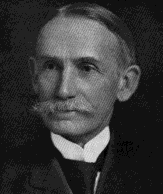- John Bates Clark
Infobox Scientist

image_width = 220px
name = John Bates Clark
birth_date = Birth date|1847|1|26|mf=y
birth_place =Providence, Rhode Island
death_date = death date and age|1938|3|21|1847|1|26
death_place =New York City
residence =
nationality = flagicon|USA American
field =Economist
work_institution =Columbia University
alma_mater =Amherst College
doctoral_advisor =
doctoral_students =
known_for =
prizes =
religion =
footnotes =John Bates Clark (
26 January 1847 –21 March 1938 ) was an American neo-classicaleconomist . He was one of the pioneers of themarginalist revolution and opponent to the Institutionalist school of economics, and spent most of his career teaching atColumbia University .Clark was born and raised in Providence, R. I. and graduated from
Amherst College in Massachusetts at the age of 25. From 1872 to 1875 he attended theUniversity of Zurich and theUniversity of Heidelberg where he studied underKarl Knies (a leader of theGerman Historical School ). Early in his career Clark's writings reflected his GermanSocialist background and showed him as a critic ofcapitalism . Upon his return to the United States, Clark taught economics, history and a whole series of other subjects at Carleton (where he taughtThorstein Veblen ), Smith and Amherst colleges before coming into contact with graduate students at Johns Hopkins. In 1895, Clark finally won a position atColumbia University .In "The Philosophy of Wealth" (1886), Clark presented an original version of
marginal utility theory , a decade and a half after the simultaneous discovery of this principle by Jevons, Menger, andWalras . Clark is better known for his use ofmarginal productivity to help explain the distribution of income ("Distribution of Wealth" (1899)). In his 1848 "Principles of Political Economy",John Stuart Mill had asserted that production and distribution were two distinct spheres. While production was determined by physical principles, such as theLaw of Diminishing Returns , distribution was the result of social and political choice. Once things were produced they could be divided up however people saw fit. Clark theorized that with homogeneous labor, perfectly competitive firms, and diminishing marginal products of any input working with another fixed input (e.g., labor working with a fixed amount of capital), firms would hire labor up to the point where the real wage was equal to the marginal product of labor; thus production and distribution are intimately connected. This idea is enshrined in virtually all modern microeconomics texts as the explanation for the demand for labor.Clark was in his work primarily inspired by his countryman
Henry George . Clark writes in the preface to The Distribution of Wealth:“It was the claim advanced by Mr. Henry George, that wages are fixed by the product which a man can create by tilling rentless land, that first led me to seek a method by which the product of labor everywhere may be disentangled from the product of cooperating agents and separately identified."
However, both Clark's son,
John Maurice Clark , and John Henry both contend that Clark developed the theory as a response toKarl Marx , who claimed that workers were being exploited of thesurplus value that they created. It is possible that Clark had both Henry George and Karl Marx in mind.The
John Bates Clark Medal , one of the most prestigious awards in the field of economics, is named after him.J. B. Clark was the father of
John Maurice Clark , who did not follow his father's conservative footsteps — instead, he became a leading Institutionalist.ee also
*
Marginal Productivity Theory Major works
*"The Philosophy of Wealth" (1886)
*"The Distribution of Wealth" (1899, 1902)
*"Essentials of Economic Theory" (1907)
*"Social Justice without Socialism" (1914).External links
* [http://cepa.newschool.edu/het/profiles/clark.htm New School: John Bates Clark, 1847-1938]
Wikimedia Foundation. 2010.
